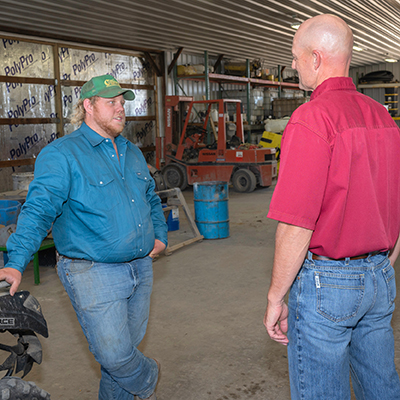5 Secret Steps to Make Your Farm a Talent Magnet

Nearly every business has the same challenge right now — hiring and retaining employees. With “Help Wanted” signs everywhere and people leaving the workforce in droves, your previous team management strategies might not work.
“We are in the greatest period of employee mobility perhaps in history,” says Bob Milligan, senior consultant at Dairy Strategies.
Why? Milligan says these factors are at play:
- The labor market was tight before the start of the pandemic.
- Employees were reluctant to change jobs during the pandemic. Many are exploring new jobs or even new careers as priorities change.
- The stresses and challenges during the pandemic resulted in many losing jobs, reducing hours or working from home.
- Incentives and circumstances make returning to the workforce unattractive or impossible. These include governmental economic benefits, children learning situations and spousal workforce situations.
“This pandemic and recovery will be a marathon,” Milligan says. “The quality of your leadership will certainly impact your business, family and employees for decades to come.”
Here are ways to be a successful leader and employer. -Sara Schafer
Be A Coach, Not A Boss
Advocate, celebrate and guide your team to help them become better people on and off the job, advises Valerie Duttlinger, chief analytics officer at Summit SmartFarms. Great coaches lead instead of demand.
“They give credit instead of taking credit,” she says. “They accept the blame instead of placing the blame. They ask for input instead of only doing it their way. They celebrate the wins but address the errors, and they constantly push a person to do more and to be more.”
Great coaches know you must have difficult conversations early.
“The longer you put off the conversation, the harder it becomes to change the behavior,” Duttlinger says. “When you let someone do it wrong over and over and then you confront them, two things happen. They feel like a fool, and they lose trust in you.” ~By Jennifer Shike

30-Year Track Record of Zero Turnover
At Frahm Farmland in Colby, Kan., employee turnover is virtually zero. How can a farm covering 33,000 acres with a team of 11 full-time and four part-time employees achieve this feat?
The recipe is simple, says CEO Lon Frahm: “We don’t hire. We select.”
While Frahm knows finding good employees is tough, it is far from impossible.
“Your goal should be to be the employer of preference in your area,” he says. “I don’t compete with other farms for employees; I compete with the implement dealer or chemical company. Given the same rewards, I’ve noticed most guys would rather be out on the farm than turning wrenches in the back of a dealership or sitting in marketing meetings.”
Frahm’s goal is to empower his employees. He provides the tools and training and then lets employees determine the path to the finish line.
“There’s no time clock, and, except for the kids working after school or on weekends, everyone is on salary — whether they drive a truck, run the grain elevator or are the accountant,” Frahm says.
Employees enjoy insurance, meals, paid time off and other normal perks, plus they have generous raises, team trips and a focus on workplace wellness. Frahm has also helped nine of his full-time employees purchase their own farmland. ~By Tyne Morgan

Understand Your Team's Motivations
To better understand your employees, you have to begin by understanding the common drivers that motivate people to work, says Jorge Delgado, training and talent development lead for Alltech T²R Program. They include:
1. DRIVE TO ACQUIRE.
“All of us want to have something we like, whether it’s a new car, a new phone or a new shirt,” Delgado says. “We can’t overlook benefits and wage — anything related to the employee’s capacity to acquire something — that’s why people work.”
2. DRIVE TO LEARN.
Delgado says trainings often focus on teaching people to be more efficient at their job. Instead, link the task to the employee’s ‘why’ in life. “If we can connect the outcomes of being efficient in animal production with their families or what they do, then we win.”
3. DRIVE TO BOND.
When creating a great internal culture, you must know your employees, Delgado says. Ask for feedback, do formal reviews and listen to what they have to say. “Sometimes we miss this important element,” he says. “Many times, employees are eager to express what they need, how they feel and have ideas on how to improve the business that’s remiss to us.”
4. DRIVE TO DEFEND.
Perhaps the key to this conversation is connecting your farm’s mission with your employee’s mission. “Everyone wants to know what they have created, what they work for, matters,” Delgado says. “If you connect their jobs to their families and that greater sense of providing and protecting their family, they will defend your farm with their lives.” ~By Jennifer Shike
6 Steps to Resolve Team Conflict
Seemingly small matters can morph into emotional trials. You want to diffuse conflicts and build a farm culture where people learn to work out small issues and let them go, says Sarah Beth Aubrey, CEO of ACT and farm business coach. “While most of us don’t like conflict, it can be productive, and it doesn’t have to last,” she says. Take these steps:
- Consider the topic of disagreement. Is it something to discuss? Could there be a problem with a system or process that needs fixing?
- Take action quickly, but never instantly. As a leader, your function is avoiding escalation, Aubrey says. Breathe and evaluate. Set a time to address the issue, and let all parties know when it will be discussed. Often, talking in the morning is best.
- Let everyone involved know when, where and exactly what will be discussed. This is not the time for secrets. Be direct and clear. Ask them to prepare and come ready to clearly explain what happened.
- During the discussion, ask each party to explain their position and role in the conflict. No one gets a free pass. Even if one person appears to be clearly in the wrong, the other might have reacted poorly causing the problem to expand like hot air in a balloon.
- Come to an agreement about what change is needed. Invite the individuals involved to determine the path.
- Take decisive action if no improvements are made. In many cases, this may mean someone leaves the team or is put in a different position. ~By Sara Schafer
'Tis The Season for Appreciation
 A simple recognition of a job well done can pay dividends in employee engagement.
A simple recognition of a job well done can pay dividends in employee engagement.
“Praise is essential to successful management,” says Mel Kleiman, president of Humetrics, a human resource consulting firm. “Everyone feels the need to be recognized as an individual or member of a group and to feel achievements.”
The holidays are a good reminder to thank your team members. Here are a few ideas to show them you value their contributions.
1. GIVE THEM AN EXTRA DAY OFF.
Let them use it when and how they’d like, suggests Susan Drumm, CEO adviser and leadership coach at MeritageLeadership.com. Maybe they’d like to leave two hours early every Friday for a month. Maybe they want to take off a Monday to stretch a holiday weekend.
“Freedom and time are enticing, attractive and appreciated things — much more so than a bottle of wine or monogrammed towels,” she says.
2. GIVE THEM A PERSONALIZED GIFT AND NOTE.
Forget the company key chain or hat, Kleiman says, instead make sure it’s something they want or need. Think about each employee’s favorite books, restaurants or weekend activities
“A thoughtful $20 gift is more appreciated than a generic $100 gift, and a handwritten note thanking them for specific things shows you actually know them,” Drumm adds.
3. PROVIDE A GIFT TO THE ENTIRE TEAM.
Think holistically of your team, Drumm says. Consider doing catered-in meals or buying a new coffee machine or exercise equipment.
4. HELP THEM FULFILL A PERSONAL GOAL.
Do you have an employee who wants to travel or learn a language? Help them plan a trip or buy the language audio guides. “They’ll appreciate the personal investment you’re making in them,” Drumm says. ~By Sara Schafer







